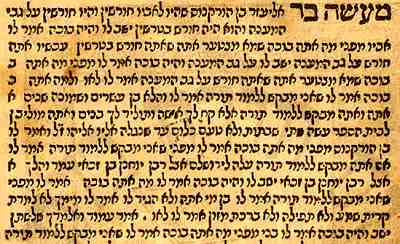
In Rabbinic Judaism, the Midrash is the body of homiletic stories told by Jewish rabbinic sages to explain passages in the Tanakh. Midrash is a method of interpreting biblical stories that goes beyond simple distillation of religious, legal, or moral teachings. It fills in gaps left in the biblical narrative regarding events and personalities that are only hinted at. The purpose of midrash was to resolve problems in the interpretation of difficult passages of the text of the Hebrew Bible, using Rabbinic principles of hermeneutics and philology to align them with the religious and ethical values of religious teachers. According to the PaRDeS approaches to exegesis, interpretation of Biblical texts in Judaism is realized through peshat (literal or plain meaning, lit. “plain” or “simple”), remez (deep meaning, lit. “hints”), derash (comparative meaning, from Hebrew darash—”to inquire” or “to seek”) and sod (hidden meaning or philosophy, lit. “secret” or “mystery”). The Midrash concentrates somewhat on remez but mostly on derash (Some thinkers divide PaRDeS into pshat, remez, din (law) and sod. In this understanding, midrash aggada deals with remez and midrash halakha deals with din). Many different exegetical methods are employed to derive deeper meaning from a text. This is not limited to the traditional thirteen textual tools attributed to the Tanna Rabbi Ishmael, which are used in the interpretation of halakha (Jewish law). Presence of apparently superfluous words or letters, chronology of events, parallel narratives or other textual anomalies are often a springboard for interpretation of segments of Biblical text. In many cases, a dialogue is expanded manifold: handfuls of lines in the Biblical narrative may become long philosophical discussions. It is unclear whether the midrash assumes these dialogues took place in reality or if this refers only to subtext or religious implication.
Many midrashim start off with a seemingly unrelated sentence from the Biblical books of Psalms, Proverbs or the Prophets. This sentence later turns out to metaphorically reflect the content of the rabbinical interpretation offered. This strategy is used particularly in a sub-genre of midrash known as the petikhta. Some Midrash discussions are highly metaphorical, and many Jewish authors stress that they are not intended to be taken literally. Rather, other midrashic sources may sometimes serve as a key to particularly esoteric discussions. Later authors maintain that this was done to make this material less accessible to the casual reader and prevent its abuse by detractors. Midrash halakha are the works in which the sources in the Tanakh (Hebrew Bible) of the traditionally received laws are identified. These Midrashim often predate the Mishnah. The Midrash linking a verse to a halakha will often function as a proof of a law’s authenticity; a correct elucidation of the Torah carries with it the support of the halakhah, and often the reason for the rule’s existence (although many rabbinical laws have no direct Biblical source). The term is applied also to the derivation of new laws, either by means of a correct interpretation of the obvious meaning of scriptural words themselves or by the application of certain hermeneutic rules.
Homiletic midrashim embraces the interpretation of the non-legal portions of the Hebrew Bible. These midrashim are sometimes referred to as aggadah or haggadah, a loosely defined term that may refer to all non-legal discourse in classical rabbinic literature. Aggadic explanations of the non-legal parts of Scripture are characterized by a much greater freedom of exposition than the halakhic Midrashim (midrashim on Jewish law.) Aggadic expositors availed themselves of various techniques, including sayings of prominent rabbis. These aggadic explanations could be philosophical or mystical disquisitions concerning angels, demons, paradise, hell, the messiah, Satan, feasts and fasts, parables, legends, satirical assaults on those who practice idolatry, etc. Some of these midrashim entail mystical teachings. The presentation is such that the Midrash is a simple lesson to the uninitiated, and a direct allusion, or analogy, to a Mystical teaching for those educated in this area.
——————–
Source: “Midrash.” wikipedia.org. Wikipedia, n.d. [http://en.wikipedia.org/wiki/Midrash]
